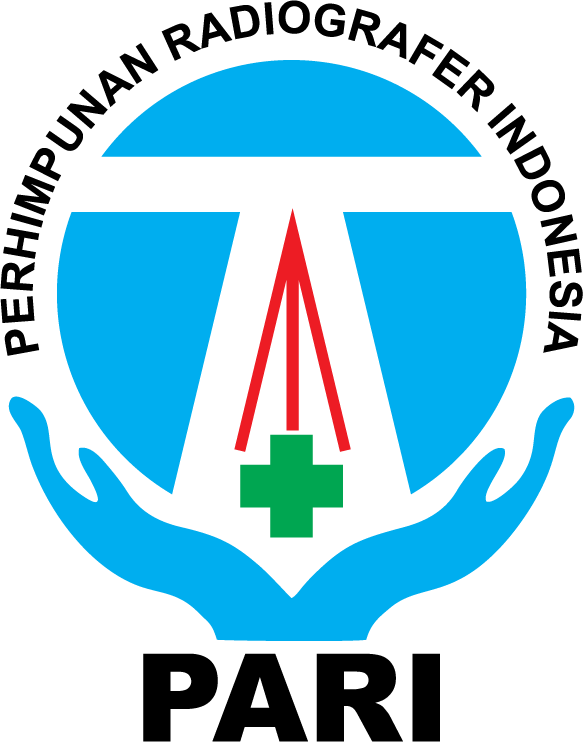Reduksi Dosis Serap Mata dengan Implementasi Software Organ Dose Modulation (ODM) pada Protokol CT Scan Sinus Paranasal
Abstract
Background: CT Scan examination of the paranasal sinuses includes organs that are sensitive to radiation exposure, one of which is the lens of the eye whose damage can be known after radiation exposure of about 500 mGy. Currently found an alternative to reduce the dose received by patients is with Organ Dose Modulation (ODM) software This ODM serves to reduce radiation dose in the eye -18.9%, Brain -10.1%, Breast -31.3%, Lung -20.7% and Liver -24%. The purpose of this study is to determine the role of ODM software in dose reduction on CT Scan SPN, determine the amount of absorption dose profile with the implementation of ODM software, differences in anatomical image information with the implementation of ODM software and without ODM on CT Scan SPN.
Methods: This type of research is quantitative with experimental studies, comparing the use of software with and without ODM to absorption dose reduction and anatomical image information of SPN. Samples using phantom performed Paranasal Sinus CT Scan procedure. Respondents consisted of 3 radiologists to assess the anatomical image of the maxillaris bone, bilateral maxillar sinus, and rice septum. Data analysis was carried out by statistical tests using SPSS Software to find the value of significance differences.
Results: The use of ODM software on CT scans of the paranasal sinuses plays an important role in reducing the absorbed dose of the eye. Statistical test results showed a significant reduction in eye absorption dose (p-value <0.05). The dose profile resulting from the use of the ODM software is a decrease in the absorbed dose by the eye by 9.75%. The value of differences in SPN anatomical information using and without ODM resulted in a p-value of 1.00 (p-value> 0.05).
Conclusion: The value of the absorbed dose of eye radiation is significantly different with and without the use of ODM. However, there is no significant difference in the SPN anatomical image information. From the implementation of the ODM software, it can reduce the absorbed dose in the eye without reducing the anatomical image information.
Keywords
Full Text:
PDFReferences
Andriani, I. & Anam dan Evi Setiawati, C. (2012). Penentuan CT Dose Index (Ctdi) Untuk Variasi Slice Thickness Dengan Program Dosxyznrc.
BAPETEN. (2016). Pedoman Teknis Penyusunan Tingkat Panduan Diagnostik Atau Diagnostic Reference Level (Drl) Nasional. Jakarta.
BAPETEN. (2020). Peraturan Badan Pengawas Tenaga Nuklir Republik Indonesia Nomor 4 Tahun 2020 Tentang Keselamatan Radiasi Pada Penggunaan Pesawat Sinar-X Dalam Radiologi Diagnostik Dan Intervensional.
Dixon MT, L. R. S. G. R. . (2016). An evaluation of organ dose modulation on a GE optima CT660-computed tomography scanner. J Appl Clin Med Phys, 17(3), 91–380.
Ega Duandini. (2021). Analisis Perbandingan Diagnostic Reference Level (Drl) Modalitas Ct Scan Sebagai Upaya Optimasi Proteksi Dan Keselamatan Radiasi Di Berbagai Negara. Ejournal.Undip.Ac.Id.
Eri Hiswara. (2013). Proteksi Radiasi Lensa Mata. Prosiding Seminar Nasional Sains dan Teknologi Nuklir PTNBR. 91–95.
Gandhi, D. (2014). The Effects of Organ-based Tube Current Modulation on Radiation The Effects of Organ-based Tube Current Modulation on Radiation Dose and Image Quality in Computed Tomography Imaging Dose and Image Quality in Computed Tomography Imaging.
Hosseinzadeh, V., & H.Ghaffari. (2021). Estimating organ dose in computed tomography using tube current modulation. International Journal of Radiation Research.
IAEA. (2014). IAEA Safety Standards for protecting people and the environment.
IAEA. (2018). IAEA Safety Standards for protecting people and the environment General Safety Guide No. GSG-7 Occupational Radiation Protection Jointly sponsored by.
ICRP. (2027). The 2007 Recommendations of the International Commission on Radiological Protection.
Rukmana, D. & V. (2021). Analisis Reduksi Dosis Efektif Mata Pada Fantom Menggunakan TLD Mata dengan Implementasi Software Organ Dose Modulation (ODM) dan Eyeshield pada Protokol CT Kepala dengan Alat GE Revolution Evo 128 Slice. Jurnal Pengawasan Tenaga Nuklir, 1(1).
Saputri, L. D., Santoso, B., Nugroho Oktavianto, A., & Anita, F. (2017). Analisis Dosis Serap CT Scan Thorax Dengan Computed Tomography Dose Index Dan Thermoluminescence Dosimeter. Jurnal Imiah GIGA.
Seeram, E. (2016). Computed Tomography Physical Principles, Clinical Applications, and Quality Control.
Tian, X., Li, X., Segars, W.P., Frush, D. P., & Samei, E. (2015). Prospective estimation of organ dose in CT under tube current modulation. Medical Physics.
DOI: https://doi.org/10.31983/jimed.v9i2.10408
Article Metrics
Refbacks
- There are currently no refbacks.
JURNAL IMEJING DIAGNOSTIK by http://ejournal.poltekkes-smg.ac.id/ojs/index.php/jimed is licensed under a Creative Commons Attribution-ShareAlike 4.0 International License.

.png)
.png)
.png)
.png)
.png)
.png)
.png)














